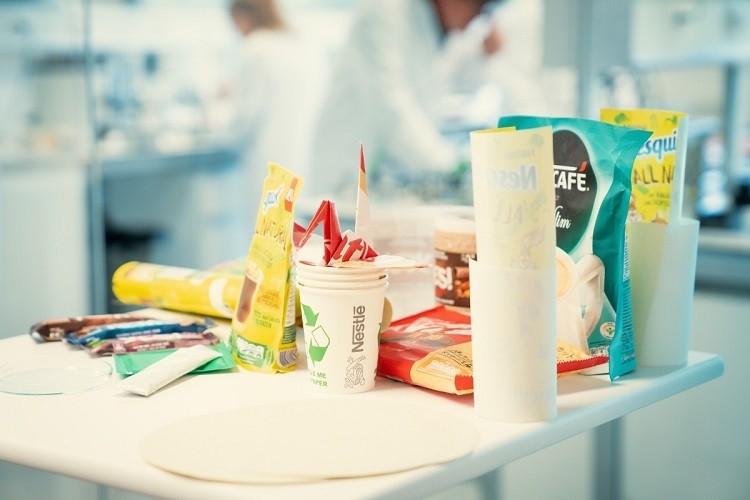(单词翻译:单击)
Plastic is everywhere.
塑料无处不在。
From the camera recording me right now to the device you’re watching this on,
无论是正在拍摄我的摄像机,还是你看这个视频用的设备,
the clothes that we’re wearing, the gallon of milk you drank straight out of this morning,
又或是我们穿的衣服,你今天早上狂饮牛奶的牛奶桶,
and the fridge that you popped it back into...which is gross, by the way.
甚至是你喝完牛奶又把它放回的冰箱……顺便说一句,这么做其实是很恶心的。
But that’s because it's a pretty awesome invention.
但这一切都是因为塑料它确实是相当棒的一个发明。
Plastic is flexible, durable, tunable, and it’s cheap.
塑料不仅有弹性、耐用、参数可调,价格还便宜。
But for all of plastic’s superpowers, it as an obvious dark side.
然而,塑料既有这些超能力,也就有它明显阴暗的一面。
It has a massive carbon footprint, wreaks havoc on our natural ecosystems,
首先,它有着超高的碳足迹,会对我们的自然生态系统造成严重的破坏。
and is so pervasive that it’s literally showing up in the food we eat and air that we breathe.
其次,由于它已经无孔不入,以至于我们的事物,乃至我们呼吸的空气中都有了它的身影。
Some would argue that we just need to quit plastic cold turkey.
于是,有些人便主张,我们应该立即停止使用塑料制品。
But because we’re so wrapped up in it, that might be easier said than done.
问题是,我们早已经被塑料牢牢包裹住了,上述提议恐怕是说起来容易做起来难。
But what if we could upgrade to something better?
但是,如果我们能将塑料改造成更好的材料会怎么样呢?
How close are we to reinventing plastic?
我们距离重新发明塑料又还有多远呢?
The life cycle of most plastics starts with petrochemicals,
大多数塑料的生命周期都是从石化材料开始的,
which are used to form some kind of source material, like these pellets, called….I kid you not…’nurdles.’
石化材料被用来制成了某种原始材料,比如这些名为“胶粒”的颗粒,我没骗你噢,它们真的就叫“胶粒”。
“So you can have these plastic pellets that get melted into something like plastic packaging for instance,
“这些塑料颗粒可以直接融化成塑料包装,
or maybe it gets blow molded into a water bottle...
或者吹塑成瓶子……
that bottle might go somewhere else, where a label gets put on top of it,
然后被送到其他地方,贴上标签,
where it goes somewhere else, where it gets filled.”
再送到另一个地方灌装。”
“Plastics are polymers. ‘Poly’ means many, and ‘mers’ means parts.
“塑料都是聚合物(polymers)。‘Poly’的意思是多个,‘mers’的意思是组成元素。
So, basically small molecules which are chained together to make a really large molecule, or a macromolecule.
也即能够连接在一起,形成一个很大的分子,即形成大分子的小分子。
Some of these macromolecules can be shaped using heat and pressure and that's what plastics are.
有一些大分子能够通过加热或加压等方式成型,塑料就是这么制成的。
So you can start with ethylene gas, you polymerize into polyethylene, which is a plastic.
比如,我们可以用乙烯气体聚合成聚乙烯,聚乙烯就是一种塑料。
And you can use it in various shapes and forms.”
聚乙烯又可以制成各种不同的形状,形式。”
Polyethylene is just one of countless types of plastics with different properties,
塑料有着数不清的种类以及各种各样的性能,聚乙烯只不过是其中的一种,
each perfectly suited for their application, from sealing a house, to lining a car, shipping a product, wrapping produce,
无论是给房屋做密封,用作汽车内饰,运输产品,包装农产品,还是让你的碳酸饮料保持充气状态,
keeping your soda carbonated or your clothing from crumbling into a million pieces when you sweat.
又或是让你的衣服避免在你出汗之后碎成渣渣,每一种塑料都能完美地匹配其用途。
(which is a different type of video).
(就不属于本期视频的范畴了)。
“Packaging is the largest consumer of polymers, or plastics. We are interacting with them every day.”
“包装消耗聚合物,也即塑料消耗得最多。而我们每天都在跟包装打交道。”
And that’s one major challenge of re-inventing plastic.
这恰好也是重新发明塑料面临的重要难题之一:
It’s finding a replacement that can do all these things.
如何研制出一种能够完成上述所有工作的替代品?
A miracle material which possesses all the incredible properties of plastic,
这种神奇的材料不仅要拥有塑料所拥有的一切惊人特性,
but is still sustainable to produce, use, and dispose of, meaning it’s both bio-based and biodegradable.
还要能进行可持续生产、使用及处理,也即要属于可生物降解的生物基材料。

“Bio-based is, where does the carbon in the material come from? Is it rapidly renewable?
“生物基针对的是材料中的碳元素是从何而来?这种碳元素是否可迅速再生?
So, if it's rapidly renewable, bio-based carbon, is it from plants? Is it from waste bio-gas?
如果是可迅速再生的生物基碳,是否又来源于植物?来自沼气废料?
Biodegradable is what happens to a material at end of life.
可生物降解针对的是材料在生命周期结束后的去向。
Can it be prone to enzymatic attack by microorganisms, by bacteria, by fungi?
是否很容易受到微生物、细菌、真菌的酶作用的影响?
Can they break it down and convert it into something else?”
它们能否将其分解,转换成其他物质?”
“PLA is polylactic acid.
“PLA就是聚乳酸。
It's one of the plastics which is bio-derived, biodegradable, or compostable.”
这种塑料是一种可生物降解的生物衍生材料。”
Right now, PLA is the most widely available “biopolymer” on the market.
它是当下市面上最常见的‘生物聚合聚’。
And you might already be familiar with it…For better or worse.
而且,你可能对它已经有所了解了……且不论是正面还是负面的了解。
“People always say, ‘oh, I know what you're talking about! I used it in my straw, in my coffee yesterday and it turned to a wet noodle.’
“经常会有人说,‘啊,这个我知道!我用的吸管,昨天喝的咖啡都用了这种材料,只不过最后都变成了垃圾。’
But one of the other bigger challenges is PLA generally will only break down in industrially compostable environments.
但聚乳酸还有一个更大的问题,那就是它只会在工业堆肥环境下分解。
It needs high heat and high pressure.
因为需要高温高压。
Industrial composting is a challenge for the same reason that recycling is:
工业堆肥和回收都是伤脑筋的问题,原因都是一样:
it’s expensive, but not profitable right away;
投入太大,却不能立马看到效益;
it requires massive infrastructure to be built from the ground up;
需要从零开始建设大规模的基础设施;
and it doesn’t catch anything that doesn’t just waltz through its door.
而且那些没有轻松进入其大门的那些废弃塑料它是一点儿奈何也没有的。
So, if you throw a recyclable soda bottle in the wrong bin or a ‘compostable’ PLA cup in your backyard, the plastic is still stuck.
也就是说,如果你把一个可回收的苏打水包装瓶扔错了垃圾箱,或是把一个“可堆肥”的聚乳酸杯子扔在了你家后院,那它就会一直停留在那里。
It’s not going to get broken down.
不会降解。
That’s why Molly and her team at Mango Materials are focused on a different kind of biopolymer.
正因为如此,莫莉和她“芒果材料”的团队才会重点研究另一种生物聚合材料。
One that degrades naturally, but only when you want it to...and rolls off the tongue: Polyhydroxyalkanoates.
那是一种能够自然降解,但只会在你想让它降解的时候降解,念起来还有点饶舌的材料——聚羟基脂肪酸酯。
“Polyhydroxyalkanoates are a family of naturally occuring biopolyesters.
“聚羟基脂肪酸酯是一类天然存在的生物聚合材料。
It's the way bacteria have evolved over billions of years to store carbon in case of famines coming.
是细菌在数十亿年的进化过程中储存碳,以备饥荒来临的方式。
PHAs were identified in bacteria over a hundred years ago.
一百多年前,人们就在细菌中发现了PHA。
The challenge has been how to commercialize them.”
问题是如何将它们商业化。”
Typically, using bacteria to produce PHA in their cell walls required feeding them something like sugar or vegetable oils.
通常,要让细菌在细胞壁中生产PHA需要给它们喂食糖或植物油之类的东西。
But because those are agricultural products, the process can be difficult at big scales.
但由于要喂的这些都是农产品,这一操作就变得很难大规模操作了。
But over a decade ago, Molly and her research team at Stanford started to toss around another idea…One that has since become revolutionary.
好在,十多年前,莫莉和她斯坦福大学的研究团队就开始考虑另一种思路了…一种从此掀起了一场巨变的思路。
“What if instead, we used methane?
“如果(把聚乳酸)换成甲烷会怎么样?
There's naturally occurring methanotrophs, or bacteria that can consume methane, and could they produce PHA?
自然界中有的是甲烷氧化菌,也即可以消耗甲烷的细菌,它们能产生PHA吗?
It would make sense that they could because this is an ancient carbon storage mechanism in organisms.
我们有理由认为它们可以,因为这是生物体中一种古老的碳储存机制。
I'd say that was the eureka moment if there was one,
我敢说,我就是在那一刻顿悟的,如果说我有过顿悟的话,
and now there's just been continual sort of successes as we validate, Can you use waste methane?
现在,我们已经取得了接连的胜利,证实了很多问题,比如能否利用甲烷废料?
What kind of properties can you get from compounding or formulating the polymer correctly?
通过正确地配制聚合材料,我们能够获得怎样的性能?
How do you scale up?”
还有如何扩大生产规模等。


